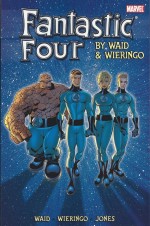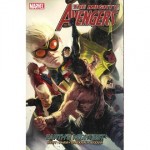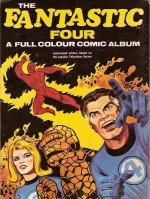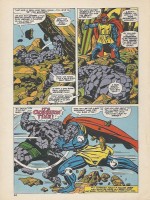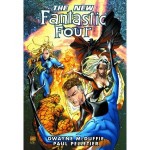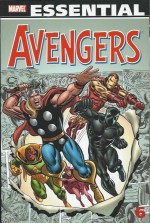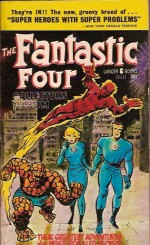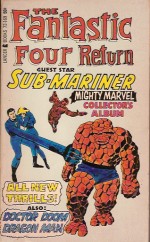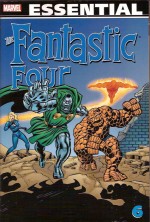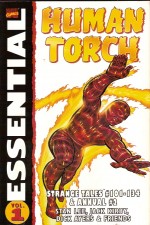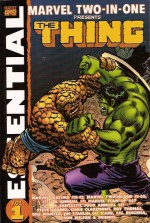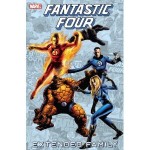
By Stan Lee & Jack Kirby, Roy Thomas, John Byrne, Steve Englehart, Walter Simonson, Dwayne McDuffie, John Buscema, Arthur Adams, Stuart Immonen, Paul Pelletier & various (Marvel)
ISBN: 978-0-7851-5303-0
The Fantastic Four has long been considered the most pivotal series in modern comicbook history, introducing both a new style of storytelling and a decidedly different manner of engaging the readers’ passionate attention. Regarded more as a family than a team, the roster has changed many times over the years and this long overdue examination from 2011 at last gathered a selection of those comings and goings to form a fascinating primer for new fans looking for a quick catch-up class.
I strongly suspect that it also performed a similar function for doddering old devotees such as me, always looking for a salutary refresher session…
If you’re absolutely new to the first family of super-fantasy, or worse yet returning after a sustained absence, you might have a few problems with this otherwise superb selection of clannish classics featuring not only Mister Fantastic, Invisible Woman, the Thing and the Human Torch but also most of the other Marvel stalwarts who have stuck a big “4†on their chests (or thereabouts) and forged ahead into the annals of four-colour heroic history.
However if you’re prepared to ignore a lot of unexplained references to stuff you’ve missed there’s a still a magically enthralling treat on offer in this terrific tome.
The Fantastic Four are – usually – maverick genius Reed Richards, his fiancée (later wife) Sue Storm, their trusty college friend Ben Grimm and Sue’s teenaged brother Johnny, driven survivors of a independently-funded space-shot which went horribly wrong after Cosmic Rays penetrated their ship’s inadequate shielding.
When they crashed back to Earth, the quartet found that they had all been hideously mutated into outlandish freaks. Richards’ body became elastic, Sue gained the power to turn invisible and, eventually, project force-fields, Johnny could turn into living flame, and poor, tormented Ben was mutated into a horrifying brute who, unlike his comrades, could not return to a semblance of normality on command.
This compilation gathers issues #1, 81, 132, 168, 265, 307, 384 and 544 of “The World’s Greatest Comic Magazine†as well as issue #42 from the third volume which began in 1998. Confusingly, the title resumed its original numbering with this tale so it’s also #471.
It all began with the November 1961 premier release which introduced ‘The Fantastic Four’ by Stan Lee & Jack Kirby and showed the mysterious Dr. Richards summoning his fiancée Sue, their friend Ben and Sue’s brother Johnny before heading off on their first mission. Via flashback we discover their incredible origins and how Cosmic Rays transformed them all into outlandish freaks…
Richards’ body had become impossibly pliable and elastic, Sue could fade away as a living phantom, Johnny could briefly blaze like a star and fly like a rocket whilst tragic Ben had been turned into a shambling, rocky freak. Shaken but unbowed the valiant quartet vowed to dedicate their new abilities to benefiting all mankind.
In ‘The Fantastic Four meet the Mole Man’ they foiled a sinister scheme by another hideous outcast who controlled a legion of monsters and army of subhuman slaves from far beneath the Earth by bravely uncovering ‘The Moleman’s Secret!’
This summation of the admittedly mediocre plot cannot do justice to the engrossing wonder of that breakthrough issue – we really have no grasp today of just how different in tone, how utterly shocking it all was.
“Different†doesn’t mean “better†even here, but the FF was like no other comic on the market at the time and buyers responded to it hungrily. Throughout the turbulent 1960s, Lee & Kirby’s astonishing ongoing collaboration rewrote the book on what comics could be and introduced fresh characters and astounding concepts on a monthly basis.
One such was The Inhumans. Conceived as an incredible lost civilisation and debuting in 1965 (Fantastic Four #44-48) during Stan & Jack’s most fertile and productive creative period, they were a race of disparate (generally) humanoid beings, genetically altered by aliens in Earth’s distant pre-history, who consequently became technologically advanced far ahead of emergent Homo Sapiens.
Few in numbers, they isolated themselves from the barbarous dawn-age humans, first on an island and latterly in a hidden Himalayan valley, voluntarily confined to their fabulous city Attilan – until a civil war brought them into the public gaze.
Old foe and charter member of the villainous Frightful Four, Madame Medusa was revealed as a fugitive member Royal Family of Attilan, on the run ever since a coup deposed her lover – the true king Black Bolt.
With her cousins Triton, Karnak and Gorgon, the rest would quickly become mainstays of the Marvel Universe, but Medusa’s bewitching teenaged sister Crystal and her giant teleporting dog Lockjaw were the real stars of the show. For young Johnny it was love at first sight, and Crystal’s eventual fate would greatly change his character, giving him a hint of angst-ridden tragedy that resonated greatly with the generation of young readers who were growing up with the comic…
Crystal stuck around for many adventures and eventually when the now-married Sue had a baby and began “taking things easyâ€, the Inhuman Princess became the first official replacement in the team.
From FF #81 (December 1968 by Lee, Kirby & Joe Sinnott) ‘Enter – the Exquisite Elemental’ saw the devastatingly powerful girl join Reed, Ben and Johnny just as incorrigible technological terror The Wizard attacked the team. In blisteringly short orderCrystal promptly pulverized murderous maniac and began a long combat career with the heroes.
After untold centuries in seclusion, increasing global pollution levels began to attack the Inhumans’ elevated biological systems and eventually Crystalhad to abandon Johnny and return to Attilan. By the time of Fantastic Four #132 (March 1973) Lee & Kirby had also split up and Roy Thomas, John Buscema & Sinnott were in charge of the show.
The concluding chapter of a 2-part tale, ‘Omega! The Ultimate Enemy!’ described how Crystal, her brand new fiancé Quicksilver and the rest of the Inhumans were attacked by their genetically-programmed slave-race the Alpha Primitives, seemingly at the behest of Black Bolt’s diabolical brother Maximus the Mad.
The truth was far stranger but the strife and struggle resulted in Medusa returning toAmericawith the team…
The more things changed the more they stayed the same, however, and by FF#168 (March 1976) Sue was back but the Thing was forcibly retired. ‘Where Have All the Powers Gone?’ by Thomas, Rich Buckler & Sinnott revealed how Ben had been reverted to normal, pedestrian humanity due to radiation exposure and a blockbusting battle with the Hulk and, deprived of the Thing’s sheer power, Reed had enlisted Hero for Hire Luke Cage as a replacement.
However the embittered Grimm simply couldn’t adjust to a life on the sidelines and when brutal bludgeoning super-thug Wrecker went on a rampage the merely mortal Ben risked life and limb to prove he could still play with the big boys…
After years in the creative doldrums the FF were dynamically revitalised when John Byrne took over scripting and illustrating the feature. Following a sequence of bold innovations the creator used the company wide crossover ‘Secret Wars’ to radically overhaul the team, and issue #265 (April 1984) revealed the big change in a brace of short tales re-presented here. Firstly in ‘The House That Reed Built’ the group’s Baxter Building HQ was the star as the automated marvel diligently dealt with a sinister home-invasion by Frightful Four alumnus The Trapster, after which Sue Richards was introduced to the Thing’s replacement (Ben having remained on the distant planet of The Beyonder for personal reasons) as the greenly glamorous She-Hulk joined up in ‘Home Are the Heroes’.
Jumping to October 1987, Fantastic Four #307 offered the most radical change yet as Reed and Sue retired to the suburbs to raise their terrifyingly mega-powered son Franklin, leaving the long-returned Thing to lead a team that consisted of the Human Torch, old flame Crystal and troubled super-strong Amazon Sharon Ventura who used the sobriquet Ms Marvel. However, before they even had a chance to shake hands, the new team was bitterly battling arcane alchemist Diablo in the gripping thriller ‘Good Bye’ by Steve Englehart, J. Buscema & Sinnott…
An even bigger shake-up occurred during Walter Simonson’s run in the gimmick-crazed ’90s. In an atmosphere of dwindling sales, high-profile stunts became the norm in comics as companies, realizing that a large sector of the buying public thought of themselves as canny “Investorsâ€, began exploiting their readership’s greed and credulity.
A plot twist, a costume change, a different format or shiny cover (or better yet covers: plural), anything – just so long as The Press got hold of it – translated directly into extra sales. There are many stories and concepts from that era which (mercifully) may never make it into trade paperbacks and collections, but there are some that deserved to, did, and really still should be.
Simonson was writing (and usually drawing) the venerable flagship title with the original cast happily back in harness and abruptly interrupted his high-tech, high-tension saga with a gloriously tongue-in-cheek graphic digression. Three issues, #347-349, poked gentle fun at the trend-meisters and speculators, consequently becoming some of the “hottest†comics of that year.
Reprinted here from FF #347 (December 1990) is that splendid first chapter ‘Big Trouble on Little Earth’ (illustrated by Arthur Adams & Art Thibert, assisted by Gracine Tanaka) which revealed how a Skrull outlaw invaded Earth, with her own people hot on her viridian high heels. Evading heavy pursuit she attacked the Fantastic Four and seemingly killed them. Disguised as a mourning Sue Richards she then recruited the four best-selling heroes in the Marvel Universe – Spider-Man, The Hulk, Wolverine and Ghost Rider – to hunt down “the murderers†as The NEW Fantastic Four!
Their hunt took them to the bowels of the Earth and into battle with the Mole Man, and revealed fascinating background into the origins of monsters and supernormal life on Earth.
What could so easily have been a cheap stunt was elevated not only by the phenomenal art of Adams but also the lovingly reverential script, which referenced all those goofy old ‘Furry-Underpants Monsters’ of immediate pre-FF vintage, and was packed with traditional action and fun besides. Sadly only the first pulse-pounding chapter is included here but you really should track down the entire tale as seen in Fantastic Four: Monsters Unleashed…
Roster change became a constant during that desperate decade. When Tom DeFalco, Paul Ryan & Danny Bulandi took over the series they tried every trick to drive up sales but the title was in a spiral of commercial decline. Reed was dead – although Sue refused to believe it – and Franklinhad been abducted. Her troubled fellow survivors had their own problems. Johnny had discovered his wife Alicia was in fact the Skrull infiltrator Lyja, Sharon Ventura was missing and Ben had been mutilated in battle and taken to obsessively wearing a full-face helmet at all times.
In #384’s (January 1994) ‘My Enemy, My Son!’, Sue hired Scott Lang AKA Ant-Man to act as the team’s science officer whilst she led an increasingly compulsive search for her lost love. No sooner had the new boy arrived than Franklin reappeared, grown to manhood and determined to save the world from his mother, whom he believed to be possessed by a malign spirit named Malice…
Following the crossover event “Onslaught†the FF were excised from Marvel’s continuity for a year. When they returned rebooted and revitalised in 1998, it was as Stan & Jack first envisioned them in a brand-spanking new volume.
Always more explorers than traditional crimebusters, the FF were constantly voyaging to other worlds and dimensions. In Volume 3, #42 (June 2001 and double-numbered as #471) Carlos Pacheco, Rafael Marin, Jeff Loeb, Stuart Immonen & Wade von Grawbadger offered a blistering battle between the Torch and old frenemy Namor the Sub-Mariner which raged through New York City whilst Reed, Sue and Ben were lost in the Negative Zone. Strapped for allies, the two then formed an alliance against mutual foe Gideon with Johnny re-recruiting Ant-Man and She-Hulk before accepting the Atlantean’s cousin Namorita as the latest part-time member of the Fantastic Four…
This meander down memory lane concludes with another major overhaul, this one stemming from the publishing event The Initiative in 2007.
Fantastic Four #544 (March of that year) featured ‘Reconstruction: Chapter One – From the Ridiculous to the Sublime’ by Dwayne McDuffie, Paul Pelletier & Rick Magyar, with Marvel’s first family bitterly divided after the events of the superhero Civil War.
After years of stunning adventures, the close-knit group split up after the Federal Superhuman Registration Act divided them; Reed siding with the Government and his wife and brother-in-law joining the rebels. Ben, appalled at the entire situation, dodged the whole issue by moving toFrance…
A story-arc from issues FF #544-550 (originally running as ‘Reconstruction’) began in the aftermath in a group reconciliation, but with temperaments still frayed and emotional wounds barely scabbed over…
When Reed and Sue attempted to repair their damaged marriage by way of a second honeymoon to the moon of Titan – courtesy of the Eternal demi-gods who inhabited that artificial paradise – on Earth, Ben and Johnny were joined by temporary houseguests Black Panther and his new wife Ororo, the former X-Man Storm.
The royal couple of Wakanda had been forced to leave their palatial New York embassy after it was bombed, but no sooner had they settled in than old ally Michael Collins – formerly the cyborg Deathlok – came asking for a favour.
A hero named Gravity had sacrificed his life to save Collins and a host of other heroes and his body was laid to rest with full honours. But now, that grave had been desecrated and the remains stolen. When the appalled New FF investigated, the trail led directly into intergalactic space…
After visiting the Moon and eliciting information from pan-galactic voyeur Uatu the Watcher, the new questing quartet travelled to the ends of the universe where cosmic entity Epoch was covertly resurrecting Gravity to become her latest “Protector of the Universeâ€.
Unfortunately she wasn’t likely to finish her magic as the Silver Surfer and Galactus’ new herald Stardust were attacking the sidereal monolith, preparatory to her becoming the World-Eater’s next meal…
For the rest of that epic you’ll need to seek out Fantastic Four: the New Fantastic Four…
With a full cover gallery and pin-ups by Steve Epting & Paul Mounts, this power-packed primer and all-action snapshot album is a great way to reacquaint yourself with or better yet discover for the first time the comicbook magic of a truly ideal invention: the Family that Fights Together…
© 1961, 1968, 1973, 1976, 1984, 1987, 1990, 1994, 2001, 2007, 2011 Marvel Characters, Inc. All rights reserved.
